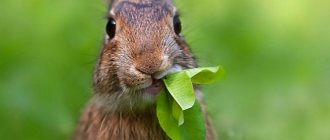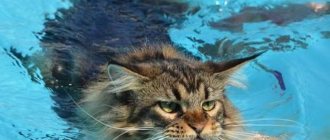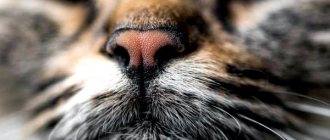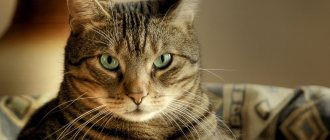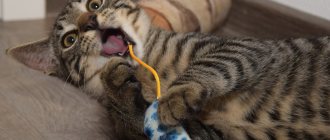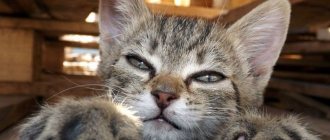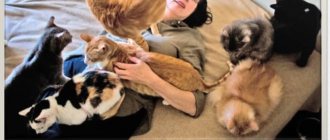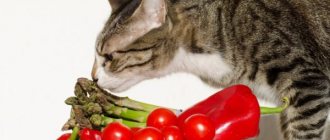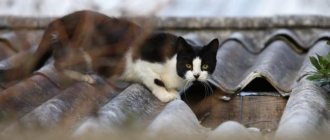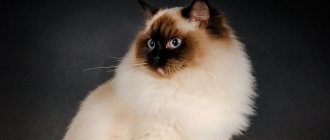According to research by felinologists, those cats whose natural habitat was near bodies of water love to swim. An additional advantage of such breeds is their hunting skills. The Kurilian Bobtail, Maine Coon and Turkish Van show a special love for water. However, almost every breed has representatives who are not afraid of swimming.
Maine Coon
Maine Coons are one of the largest domestic cats that are not afraid of water. Since their fur is waterproof, animals can withstand even low temperatures without harm to their health. However, Maine Coons' love of water has earned them a "dirty" reputation, as cats love to stick their paws in the toilet, figure out how the kitchen faucet works, or even dip their toys in dishes filled with water. Maine Coons are considered to be very intelligent, and their love of water stems from the breed's history of being used on warships to control rodents.
How to properly wash a cat?
It’s one thing to teach your pet to stand calmly in the water or even move around within the bathroom; it’s another thing to wash it. The preparation rules are the same - warm water is poured into a basin or bath in advance so as not to frighten the animal with the noise of the flowing water stream. Place a non-slip mat on the bottom. It is better to call a second person for help who can hold the animal while it is soaped and then the shampoo is washed off.
You can wet your cat and wash off the foam with a shower, choosing the weakest pressure
To wash cats, only specialized pet shampoos are used that do not dry out the pet’s delicate skin. You also need to have a small ladle on hand, with which you need to gently wet the animal. You need to talk to the cat kindly, holding it so that it does not slip or jump over the side of the bathtub.
Tips for choosing shampoo for a cat
The shampoo does not need to be immediately poured onto the animal, you need to warm it and foam it in your hands, and only then transfer it to the fur. Human movements should be light, massage, care must be taken to ensure that foam does not get into the eyes, and water does not get into the pet’s ears.
After the cat has been washed and the remaining shampoo has been washed off, you need to flush the bath and wrap the animal in a large towel or terry sheet. It will take some time for the fabric to absorb excess moisture. A wet cat should not be released on the floor so that it does not freeze and catch a cold in the draft. When the fur becomes barely damp, the pet can be licked.
Cat breeds with the most affectionate and calm personalities
Peace and tranquility in the house depend on the character of the pet. The affectionate and balanced cat spends his evenings in a chair with his owner, is loyal to children, and does not conflict with other animals.
Ragdoll
If you ask which cats are the most affectionate and calm, then you cannot find a better ragdoll breed. The name of the breed is translated as “rag doll”.
A large, but cute and clumsy pet, which was obtained by crossing Burmese and Angora cats, is absolutely devoid of aggression and the hunting instinct, and allows itself to be squeezed like a toy. The Ragdoll is kind, balanced, flexible, not talkative, and needs constant contact with its owner.
Shorthair exotic
A stocky cat with a flat nose and a touching expression on his face is popular all over the world. The breed is friendly, playful, and devoid of aggression. The pet needs the constant presence of a person, willingly participates in children's amusements, gets sick from loneliness and separation from its beloved owner, and has difficulty adapting to a changed environment.
Shorthair exotic
Russian blue cat
A sweet, affectionate, friendly pet readily communicates with children, treats guests with confidence, and gets along with a dog if it grew up with one from an early age. But the breed cannot be called affectionate.
The Russian cat easily tolerates short-term loneliness, does not like changes in environment, plays with the child whenever she wants, and is characterized by territorial behavior and restraint in showing emotions.
Maine Coon
Large native cat from the USA. Despite his harsh appearance, he is affectionate, flexible, intelligent, and amenable to training. The pet subtly senses the inner state of a person, is always open to communication, is friendly towards all household members, and does not shy away from guests.
Favorite pastime is sitting on the owner's lap. The attitude towards children is neutral, but it is better not to have a large cat with a developed hunting instinct for a family with a baby.
Burmese cat
In the photo, the Burmese looks graceful, willful, freedom-loving, a real predator. In fact, the breed has a gentle, sociable, cheerful character. The cat, infinitely devoted to its owner, tries to always be nearby, even sleep near the owner’s bed.
Burma loves to purr, looking into the owner's eyes, and the quiet and gentle voice of the cat calms and relieves stress.
Oriental
The description of the cat’s appearance is very exotic: huge ears, a narrow muzzle, an elongated and lean “oriental” build. Orientals are loved not only for their external originality, but also for their wonderful character.
The pet is non-aggressive, affectionate, non-offensive, talkative, friendly and trusting towards guests. Loves to play active games.
Siberian cat
Despite their autonomy and independence, “Siberians” become strongly attached to their owner and willingly participate in children’s games. The breed attracts with its balance, tact, intelligence, and spontaneous behavior. The cat is quiet and hardy.
Siberian cat
Sphinxes
Several varieties of Sphynxes have been bred, and all of them can be called the most tame cat breeds. The naked cat loves his owner immensely, loves to sit in his arms, and warm himself under a warm blanket in the owner’s bed. But it does not impose itself when the owner is busy.
Sphinxes lack aggression, are not touchy, and treat guests with trust. They react loyally to children's pranks and coexist peacefully in the apartment with other animals.
Persian cat
The breed is loved not only for its aristocratic manners and luxurious appearance, as can be seen in the photograph, but also for its kind, calm, affectionate character. “Persian” is phlegmatic, stubborn, plays according to his mood, prefers to lie on his master’s lap, and is indifferent to children and other animals.
He responds to love and kindness with endless devotion. The breed is in demand, widespread, the price of a purebred kitten is up to 30 thousand rubles.
Scottish fold cat
Phlegmatic, calm, sweet. He doesn’t intrude, he can spend hours watching a person go about his business. She is restrained in her expression of emotions, does not tolerate squeezing and noise, but becomes strongly attached to her owner and greets him at the door from work.
“Scotsman” is a good companion for a lonely person who does not like noisy gatherings.
Manx
A tailless cat breed with plush-feeling fur. The complete absence of a tail is observed in the best individuals. Manx grow very quickly, have average activity, but love to play, have strong hind legs, jump well, and love to climb high places in the house.
They love water, play with streams of water, and watch water from the tap. They can swim with their owner in the lake or even in the bathtub. It is not recommended to bathe Manx cats frequently, so as not to wash off the protective layer on the coat. During bathing they behave without whims.
American Bobtail
If a dog could become a cat, it would certainly be a Bobtail. Representatives of this breed, unlike cats that prefer to walk on their own, are very fond of the company of their owners, walking together, training and playing. The Bobtail is sometimes called the retriever of the cat world.
Even on a walk, this cat will not pass by a pond and will happily climb into it to play, not to mention the home bath, which must be kept tightly closed while washing.
Dislike of water
Basically, cats don't like water. This is due to the fact that their ancestors lived in desert areas, and swimming was unusual for them. The second reason is that the wool gets wet. It becomes heavy and sticks to the skin. The cat feels extremely uncomfortable. He seems to be left without a protective shell, so he feels helpless. You've probably seen a picture where a pet, after bathing, hides in a corner and becomes quiet and unnoticeable until the fur dries.
Mandatory process
Cats constantly clean their own fur, licking themselves from the tips of their ears to their tail. For this they can be called one of the neatest animals. However, they still need bathing. It should not be frequent (no more than once every three months), but this process is necessary, since the cat may become ill or become infected with parasites. The owner must take care of his pet and, despite the cat’s dislike for water, try to teach him to bathe from childhood. Create all the conditions to make your pet comfortable and start washing. How to do this correctly, you can find out in more detail on the Internet or consult a veterinarian.
Wrapping gifts: a simple trick with cling film and napkins
How to do housework correctly: the guy “challenged the carpet to a duel” (video)
Each has a separate “room”: an unusual bunk bed for boys
And here are those breeds whose owners can consider themselves lucky. Their cats enjoy water treatments.
Why do dogs love to swim so much, unlike cats?
This can be explained by several facts. The structure of a dog's fur is different from that of a cat's; as a rule, it is thinner and longer, and water drains easily from it. Dogs carefully shake off their fur when leaving the water. Also, in dogs, thermoregulation is additionally regulated by breathing activity. If it's hot, the dog sticks out its tongue and breathes quickly.
A dog’s specific smell is present even when the coat is dry, so getting it wet doesn’t really change anything. Dogs by nature are pack animals and hunt by stalking rather than tracking prey. And they are not particularly afraid of predators; they are unlikely to suddenly attack an entire flock.
Some people love to keep company with the owner while he is taking a shower, while others like to cool off under the stream of water pouring from the tap. Often these are breeds such as: Bengal cats, Siamese, Somalia, Orientals, Thais, Turkish Vans, Angoras, Sphynx, Rex, Kuril Bobtails, Savannahs, Abyssinians.
What you need and what you don’t need to do while bathing
Before the procedure, veterinarians recommend thoroughly combing the cat and removing tangles. Then insert cotton balls into your pet's ears or put a special cap on his head. After this, the massage mitten is moistened in water, and a detergent is applied to its surface. After foaming, the shampoo is gently rubbed into the animal’s fur with massage movements. There is no need to press hard, otherwise it will scare the animal even more, and then it will be much more difficult to restrain it.
Bathing a cat in a basin
If you are planning to bathe your cat in a basin, then place it in the bathtub. It is better to line the bottom of the basin with a terry towel or rug so that the cat does not slip. The room in which bathing takes place must be cleared of foreign objects, otherwise they risk ending up in the bathtub (basin) or, worse, on the cat’s head.
Water is also important when bathing an animal. Its temperature should not exceed 40°C and be at least 36°C
Veterinarians pay attention to the proper water level. It should not be higher than the level of the pet’s stomach
Therefore, there is no need to fill the bathtub (basin) to the top. If the cat does not feel the bottom under his paws, this can greatly frighten him.
Thermometer for measuring water temperature (without mercury)
Be sure to trim the animal’s claws before the procedure.
It is very important. This way you will protect yourself from possible scratches and damage.
There should be no loud sounds, screams, or pressure. Try to be calm and affectionate.
It is more convenient to bathe a cat together. Immediately assign roles - who will hold the animal and who will bathe it. It is better to entrust the bathing process to the person the cat loves most.
What cats love water?
Turkish Van cat
These animals' natural habitat is associated with water, which is why they are not afraid of it.
The breed, which accidentally originated near Lake Van in Turkey, had fresh fish as its main source of food, so the animals were accustomed to actively spending time in the water. Vans have no undercoat, so they dry completely within 5-10 minutes if they are in the sun and do not experience cold. At home, cats of this breed prefer to frolic with the flow of tap water and swim in the bathtub. The pet chooses one main family member and shows him increased care and attention. It is rarely aggressive towards people, so it can be adopted by families with small children. Van often shows emotions, purring, raising his voice and jumping on his lap.
Friendly Bengal
The hybrid, obtained by crossing a domestic cat and a Bengal cat, has good contact with dogs and children, so it can be owned in large families. The active cat loves games, enjoys walking outside and swimming in ponds. You can take it fishing. This breed does not require special nutrition. A characteristic feature is the spotted color, although there are representatives of the species with marbled fur. The animal is very curious and requires increased attention. Felinologists do not recommend getting a Bengal if it is not possible to spend time with him every day.
American Maine Coon
Such pets enjoy spending time in open water and can fish.
The largest cats from Maine were previously used on ships to catch rodents. The advantage of this species is its large size, lack of fear of water and hunting skills. The cat loves to swim in natural bodies of water. It can catch mice and rats, and also bring fish to its owner. The breed has a habit of using its paw together with a spoon and drinking water this way. The Maine Coon has a calm and non-aggressive character. It is not recommended to have an animal in a small apartment due to its size and need for free space.
Kurilian Bobtail
Representatives of the friendly breed resemble dogs in their habits - they like to fetch a ball, follow basic commands and swim in bodies of water. Due to their large size, bobtails, which originated on the Kuril Islands, are good hunters and fish catchers. They are picky about their diet and require natural animal food - fresh meat, vegetables and cereals. An additional plus of the bobtail is the patience shown to intrusive children. Cats are very smart, rarely meow, never show aggression and do not mark territory. With regular training they can learn 6-7 commands.
Turkish Angora
So that the kitten is not afraid to swim, the first acquaintance with the water should be done carefully, allowing him to go in and swim. Coercion is unacceptable.
The artificially bred breed has long and fluffy snow-white fur. The little cat has a playful character and is very active. Pets of this breed love water and often go into the shower with their owner. Angoras want to be constantly close to their owner, and if they do not receive enough attention, they begin to meow. However, their voice is pleasant. The Turkish cat is very curious and intelligent, and therefore easily opens cabinets and purses. Can live in small apartments.
The role of salt in cat metabolism
10 dog breeds that are rare
Like sugar, salt plays a vital role in the metabolism of living organisms. Therefore, of course, it is impossible to completely eliminate salt from an animal’s diet. And here the question of the norm arises. What is the optimal amount of salt for furry pets? Modern experts are of the opinion that salt (as well as sugar) is present in the natural diet of animals, and this amount is more than enough, that is, there is no need to additionally offer the animal sodium chloride.
Yes, meat contains very little carbohydrates and salt, but since ancient times the cat’s body has been adapted to precisely this amount of salt. More salt in the body will cause the cat to drink more, and this will cause the leaching of minerals. In addition, excessive salt consumption leads to metabolic disorders and, as a result, serious health problems.
But a complete absence of salt is not good. Sodium chloride has many beneficial functions in the body. Firstly, it is an element of metabolism that ensures proper nutrition for cats. Cell walls allow salt and nutrients to pass through, which displace potassium and waste products. If there is no salt in the body, there will be nothing to squeeze potassium out of the cells - this will lead to intoxication and death of living tissues.
In addition, salt promotes the digestion of food, as it is part of the gastric juice. A deficiency of sodium chloride leads to incomplete absorption of food, metabolic disorders, and the development of diseases.
Turkish van
www.petbucket.com
It seems that this indigenous breed of semi-longhaired cats has no idea that it should be afraid of water. For centuries she lived near the island of Van in Turkey, where she fished and swam just for fun. Due to the absence of undercoat, wet wool dried very quickly and did not cause discomfort.
The Turkish Van loves to play with trickles of water in the sink and splash around in the filling bathtub. He becomes very attached to one owner, although he usually gets along well with the rest of the family. Very talkative and emotional, loves to be the center of attention and sit in arms.
How to train a cat to drink water from a bowl?
To train your cat to drink water:
- Choose convenient utensils. ...
- Change the liquid in the dishes daily;
- Mix water with dry food, add it to cat dishes, milk, and so on;
- Buy ready-made canned foods that contain water;
- If the cat does not have throat problems, you can put an ice cube in the bowl.
Mar 20
2022 Interesting materials:
How to restore Google Play Music? How to restore lemon? How to recover a Kaspersky license key? How to restore lost Snils? How to restore the surface of a frying pan? How to restore a previous save in The Sims 4? How to restore the TV remote control? How to restore threads on a stud? How to restore an old account in WOT Blitz? How to restore an old Warface account?
